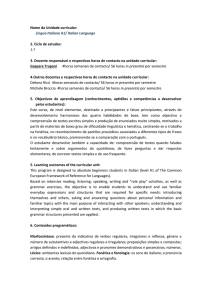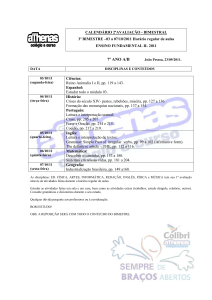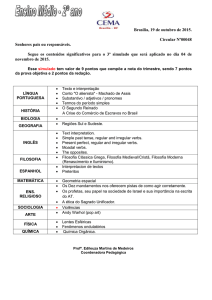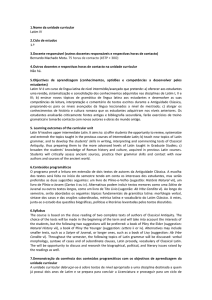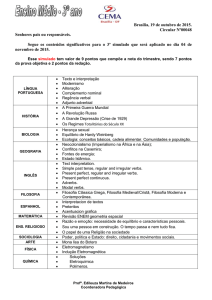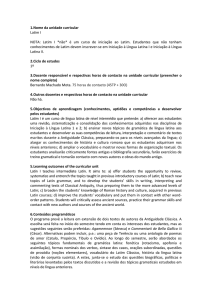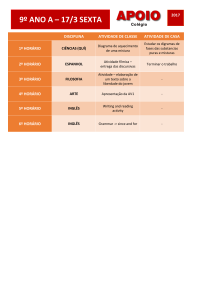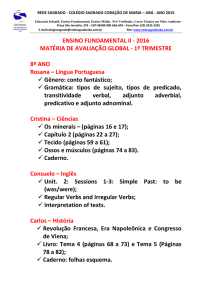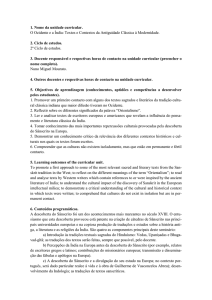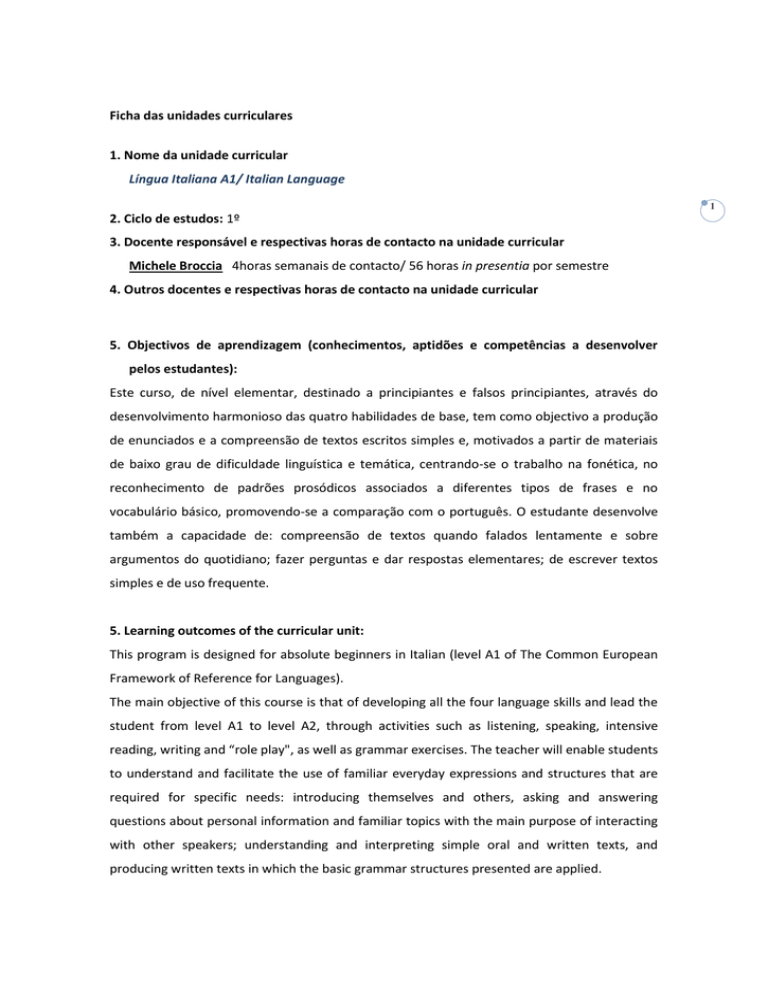
Ficha das unidades curriculares
1. Nome da unidade curricular
Língua Italiana A1/ Italian Language
1
2. Ciclo de estudos: 1º
3. Docente responsável e respectivas horas de contacto na unidade curricular
Michele Broccia 4horas semanais de contacto/ 56 horas in presentia por semestre
4. Outros docentes e respectivas horas de contacto na unidade curricular
5. Objectivos de aprendizagem (conhecimentos, aptidões e competências a desenvolver
pelos estudantes):
Este curso, de nível elementar, destinado a principiantes e falsos principiantes, através do
desenvolvimento harmonioso das quatro habilidades de base, tem como objectivo a produção
de enunciados e a compreensão de textos escritos simples e, motivados a partir de materiais
de baixo grau de dificuldade linguística e temática, centrando-se o trabalho na fonética, no
reconhecimento de padrões prosódicos associados a diferentes tipos de frases e no
vocabulário básico, promovendo-se a comparação com o português. O estudante desenvolve
também a capacidade de: compreensão de textos quando falados lentamente e sobre
argumentos do quotidiano; fazer perguntas e dar respostas elementares; de escrever textos
simples e de uso frequente.
5. Learning outcomes of the curricular unit:
This program is designed for absolute beginners in Italian (level A1 of The Common European
Framework of Reference for Languages).
The main objective of this course is that of developing all the four language skills and lead the
student from level A1 to level A2, through activities such as listening, speaking, intensive
reading, writing and “role play", as well as grammar exercises. The teacher will enable students
to understand and facilitate the use of familiar everyday expressions and structures that are
required for specific needs: introducing themselves and others, asking and answering
questions about personal information and familiar topics with the main purpose of interacting
with other speakers; understanding and interpreting simple oral and written texts, and
producing written texts in which the basic grammar structures presented are applied.
6. Conteúdos programáticos:
Elementos comunicativos e lexicais: Apresentar-se, cumprimentar, dizer a nacionalidade,
perguntar e dizer: o seu nome, a idade, o dia da semana, as horas, os horários de abertura e
fechamento das lojas; os números cardinais e ordinais, falar ao telefono, perguntar como está
uma pessoa, tratar de tu e de você, descrever uma pessoa, falar do tempo livre e das
atividades do fim de semana, aceitar e rejeitar uma chamada, pedir e dar a morada, descrever
a habitação, localizar os objetos no espaço, expressar a incerteza, a duvida, a posse; agradecer
e responder, meses, estações, falar dos preços; falar sobre o passado e das atividades de
lazer, contando o passado, expressões de tempo no passado, ordenar e oferecer na tasca ou
no bar, expressar preferências , ementa das bebidas, fazer planos , previsões , hipóteses,
promessas para o futuro, expressões
úteis para viajar de comboio, falar do tempo
meteorológico, conhecer o léxico de ambientes do quotidiano.
Gramática: Alfabeto,
presente do indicativo de verbos regulares, irregulares e reflexos;
género e número de substantivos e adjectivos regulares e irregulares; preposições simples e
compostas; artigos definidos e indefinidos; adjectivos e pronomes demonstrativos e
possessivos; números; possessivos, particípio passado, “passato prossimo” dos verbos
regulares e irregulares, auxiliares avere ou essere, Futuro simples, futuro composto.
Fonética e fonologia: os sons do italiano; a pronúncia correcta; o acento; relação entre
fonética e ortografia.
6. Syllabus:
The program is based on a communicative approach to language and therefore students will
learn how to use language expressions and notions on a communicative context and grammar
will be taught on a deductive basis, reinforced with activities or exercises.
During the course the following language functions and lexicon will be dealt with: Italian
words in the world; Spelling; Introducing oneself, Greeting, Nationalities, Saying nationalities,
How to write complete simple sentences; Cardinal and ordinal numbers, Asking and saying:
one’s name, one’s age, the day of the week, the time, the opening and closing time of shops,
offices,…;Talking on the phone, asking how a person is, writing an e-mail, asking and giving
information, meeting people, Greeting and replying to greeting, Talking in a formal way (dare
del Lei), Describing a person’s body and character, Parts of a body and face; Free time,
Activities of the weekend, Inviting; accepting and refusing and invitation, Asking and giving
one’s address, describe one’s house, the days of a week, sending an envelope, a parcel; Saying
where objects are, Express certainty and uncertainty, doubt; Express possession, Thanking and
replying to thanking, Months and seasons, Talking about prices; Talking about the past, Telling
2
about past events, Expressions of past time, Order and offer at the bar, Price list, Express
preferences; Italian feast and festivals, Make plans, hypothesis, promises for the future;
Hypothetical sentence (1st type); Expressions useful to travel by train; Talking about weather,
Organize a trip.
Grammar: Alphabet, Pronunciation, Nouns and adjectives, Subject Personal pronouns, Present
tense, Determinative and indeterminate articles, Verbs avere e essere, The three conjugations
(-are,-ere,-ire); Irregular verbs,modal verbs, Prepositions, Prepositions with articles,
Expressions of place, c’è-ci sono, Possessives, Passato prossimo, Past participle of regular and
irregular verbs, auxiliary verbs avere or essere, Adverb ci, Adverbs used with passato
prossimo,, Future simple (regular and irregular verbs), Futuro compost, uses of future in
Italian.
The syllabus will therefore contain the the basic Italian grammar structures, as well as
phonetic, morphological and lexical features.
7. Demonstração da coerência dos conteúdos programáticos com os objectivos de
aprendizagem da unidade curricular.
O objectivo principal desta cadeira consiste na aquisição da capacidade de utilização e
compreensão de textos orais e escritos simples. A compreensão do italiano falado lentamente
assim como a produção de enunciados muito simples, orais e escritos, motivados a partir de
materiais de baixo grau de dificuldade linguística e temática será também uma finalidade deste
nível elementar. O estudante, no final do curso terá aprendido e compreendido, através o uso
de uma metodologia de tipo comunicativo, os conteúdos programáticos da cadeira. Estes
correspondem ao que é pedido no Quadro Europeu do ensino da língua.
7. Demonstration of the syllabus coherence with the curricular unit's objectives.
This is the absolute beginners level user of Italian. This course helps students to:
understand the main points of clear standard input on familiar matters regularly encountered
in work, school, leisure, etc. deal with most situations likely to arise whilst travelling in an area
where the language is spoken;
Produce simple connected text on topics which are familiar or of personal interest;
Describe experiences and events, dreams, hopes and ambitions and briefly give reasons and
explanations for opinions and plans.
3
8. Metodologias de ensino (avaliação incluída):
A metodologia utilizada vai ser de tipo eclético, quer dizer que dentro de uma abordagem
comunicativa o professor também usará os métodos tradicionais de ensino, de maneira que a
aprendizagem possa ser tão eficaz quanto possível para o maior número de alunos. Os alunos
poderão fazer atividades de role play, de grupo, houver canções, e fazer exercícios de
gramática, preencher módulos, etc.
A avaliação é contínua e visa verificar a aprendizagem dos conteúdos programáticos: os
elementos comunicativos e lexicais e a gramática.
Como formulado do Regulamento de Avaliação definem-se o numero, a categoria e o valor
percentual relativo das provas e dos outros elementos de avaliação:
-Participação, trabalhos de casa, disciplina, assiduidade e eventual apresentação de trabalhos
(10% - 2 pontos);
-Competência comunicativa oral (falar) (20% - 4 pontos), avaliada ao longo das aulas com
atividades decididas do professore;
-1 Teste (Primeiro teste) de competência gramatical, metalinguística e lexical (30% - 6 pontos),
baseado sobre a primeira parte do programa;
-1 Teste (Segundo teste) de competência de leitura e gramatical, uma breve redacção escrita,
prova oral (escutar) (40% - 8 pontos), baseado sobre a segunda parte do programa).
8. Teaching methodologies (including evaluation):
The teacher will use an eclectic methodology within a communicative general approach. It
means that the main objective will be that of leading students to acquire a communicative
competence at an elementary level. Eclecticism means that the teacher will avail oneself of
different methods, activities or exercises, in order the teaching to be more effective as possible
for the higher number of students. Therefore students will carry out role plays, pair or group
activities, listen to songs, do grammar exercises, fill in forms, etc.
Evaluation is continuous and aimed at verifying the program contents: lexicon and
communicative features and grammar notions.
In accordance with the Rules of Evaluation the number, genre and percentage value attributed
to the different evaluation methods are the following:
-Participation, homework assignments, discipline, attendance and the possible presentation of
written assignment (10% - 2 points);
- Oral communicative competence (speaking), (20% - 4 points), evaluated during classes;
- 1 test (first test) based on grammar, lexicon and communicative competence acquired during
4
the first part of the course (30% - 6 points);
- 1 Reading, writing, listening tests. The short composition will be on topics studied during
classroom sessions. The test will be based mainly on the program carried out during the
second part of the course (40 %) – 8 points;
9. Demonstração da coerência das metodologias de ensino com os objectivos de
aprendizagem da unidade curricular.
Tendo em conta os descritores do Quadro Comum Europeu de Referencia para as Línguas,
este nível, baseia-se em princípios metodológicos graças aos quais o estudante poderá ser
capaz de comunicar oralmente e por escrito com facilidade e segurança em situações reais.
Respeitando portanto o modelo europeu de competência linguístico-comunicativa, a
aprendizagem basear-se-á na articulação das 3 sub- competências: competência linguística;
competência sociolinguística e competência pragmática. Consequentemente uma particular
importância será dada ao desenvolvimento das capacidades comunicativas estimuladas
através de actividades como jogos de role-play; estudo de material autêntico; canções; vídeos.
Ao mesmo tempo será feita uma constante reflexão gramatical com momentos de reforço e
sistematização dos conceitos apreendidos. Grande relevo será dado também à discussão sobre
a vida e a cultura italiana. Filmes, vídeos sobre a actualidade; leituras de textos de jornalistas e
escritores contemporâneos; noções sobre a língua, as suas origens, a história, a literatura, o
cinema, serão parte do curso. Os estudantes serão capazes de chegar aos objectivos prefixados
participando em trabalhos de grupo, desenvolvendo trabalhos individuais, fazendo pesquisas
sobre aspectos socioculturais, assistindo a sessões de cinema, participando a visitas de estudos
e eventos culturais promovidos pela Embaixada de Itália.
9. Demonstration of the coherence between the teaching methodologies and the learning
outcomes.
The complexity of the topics presented and dealt with during classroom sessions increase as
students develop their proficiency in the language. Students are constantly and progressively
challenged with more complex Italian structures that they will learn to master, (self) assess
and improve. The final evaluation tests are in accordance with official tests providing
certification of proficiency in Italian.
5
10. Bibliografia de consulta/existência obrigatória.
T. Marin, Nuovo Progetto Italiano 1 – Libro dello studente, Edizioni Edilingua, Roma, 2009.
[Unità 1-5]
T. Marin, Nuovo Progetto Italiano 1 - Quaderno degli esercizi, Edizioni Edilingua, Roma,
2013.
M. Ricci, Via della Grammatica, Edizioni Edilingua, Roma, 2014.
Lista sites de língua e cultura, exercícios on-line.
Dicionário: Lo Zingarelli Minore, Ed. Zanichelli (dizionario monolingue)
Outro material utilizado: fotocópias de língua e cultura; dvds (filmes e documentários); power
points; cd-audio.
6

